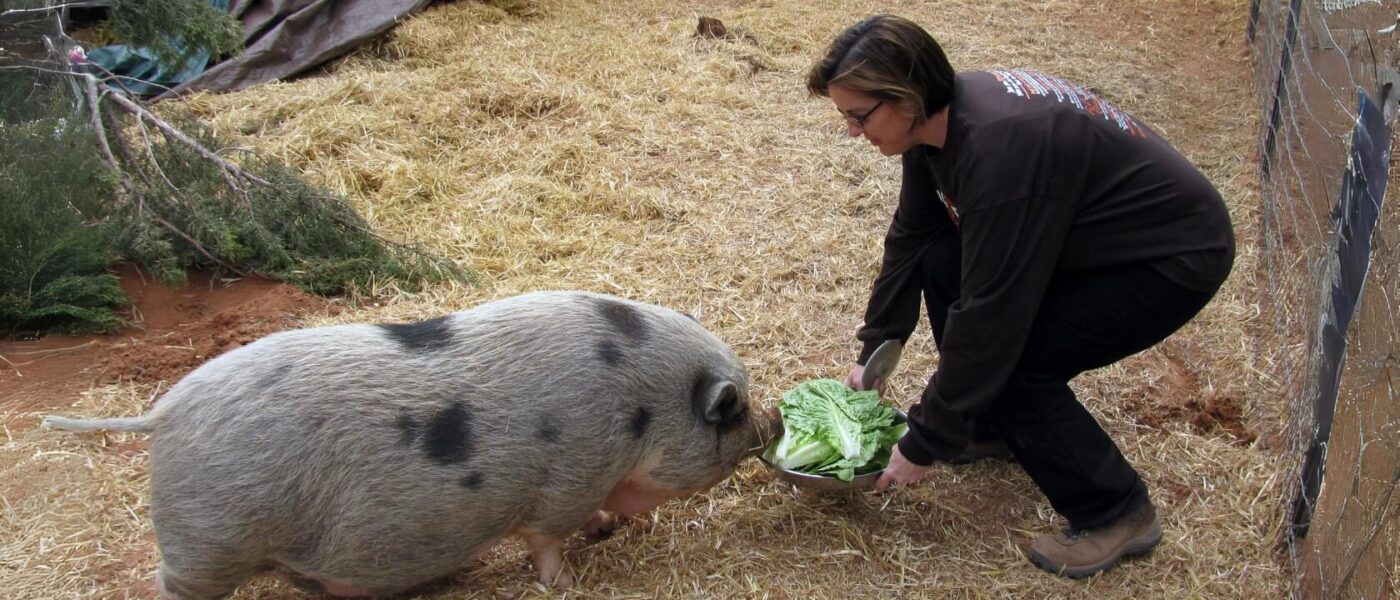The Best Pig Feed Options for Optimal Health and Growth
Introduction
Raising healthy and productive pigs requires a delicate balance of providing the proper nutrition at every growth stage. Pigs need a carefully crafted diet from birth until they reach market weight to fuel their rapid development and ensure optimal performance. However, with many available options, choosing suitable pig feed can take time for commercial and small-scale producers.

In this comprehensive guide, we’ll explore the various types of pig feed, nutritional requirements, feeding management practices, and common issues pig farmers face. This article will give you the information and tools, regardless of your experience level, to help you make wise choices about your pigs’ nutrition, which will eventually result in healthier animals, higher weight gain, and more profitability.
We’ll cover everything from understanding the importance of protein and energy sources to navigating the complexities of feed additives and sustainable feeding practices. So, let’s embark on this journey together and unlock the secrets to providing your pigs with the best possible nutrition, ensuring their well-being and your success in the industry.
Types of Pig Feeds: Tailoring the Diet for Every Stage
When raising healthy and productive pigs, one size doesn’t fit all. Just like humans, pigs have unique nutritional needs at different stages of their lives. Their diets must be carefully crafted from the delicate starter phase to the robust finisher stage to support their growth, development, and overall well-being. In this article, we’ll explore the two main categories of pig feeds – commercial and home-mixed – and dive into the specifics of each type to help you make informed choices for your livestock.
Commercial Pig Feeds: Convenience and Precision
For many pig producers, commercial feeds offer a convenient and reliable solution. Experts formulate these feeds to meet pigs’ nutritional requirements at various growth stages. Let’s take a closer look at the different types of commercial pig feeds:
1. Complete Pig Feeds
Complete Pig feeds are designed to provide all the essential nutrients a pig needs in a single package. Generally, they fall into one of three primary types according to the animal’s developmental stage:
- Starter Feeds: These are high-protein feeds designed for young pigs from weaning (around 3-4 weeks) until they reach 25-30 lbs. Starter Pig feeds Support the rapid growth and development of piglets during this crucial phase.
- Grower Feeds: Once pigs reach the grower stage (around 25-50 lbs), they transition to grower Pig feeds, formulated with a balanced blend of protein, energy, and minerals to sustain their steady growth.
- Finisher Feeds: As pigs approach market weight (around 250-300 lbs), finisher Pig feeds provide the necessary energy and nutrients to support the final growth and muscle development stages.
2. Concentrate Pig Feeds
Concentrate Pig feeds are nutrient-dense supplements that are typically mixed with grains or other energy sources on the farm. They are divided into two main categories:
- Protein Sources: These concentrates provide a high-quality source of protein, such as soybean meal, fishmeal, or other plant or animal-based proteins. They are essential for muscle growth and development.
- Energy Sources: These concentrates are rich in carbohydrates and fats, providing the necessary energy for growth and maintenance. Examples include corn, wheat, and various oil seeds.
3. Premixes and Supplements
In addition to complete and concentrate Pig feeds, commercial producers also offer premixes and supplements to address specific nutritional needs or deficiencies. These may include:
- Vitamin and Mineral Premixes: Concentrated sources of essential vitamins and minerals to ensure proper health and growth.
- Specialty Supplements: These are targeted supplements designed to address specific issues, such as improving gut health, enhancing immune function, or boosting reproductive performance.
Home-Mixed Pig Feeds: Flexibility and Cost-Effectiveness
Home-mixing Pig feeds can offer greater flexibility and cost-effectiveness for smaller-scale or speciality pig operations. However, a solid understanding of pig nutrition and precise formulation is required to ensure the animals receive a balanced diet. Here’s what you need to know about home-mixed pig feeds:
Ingredients for Home-Mixed Pig Feeds
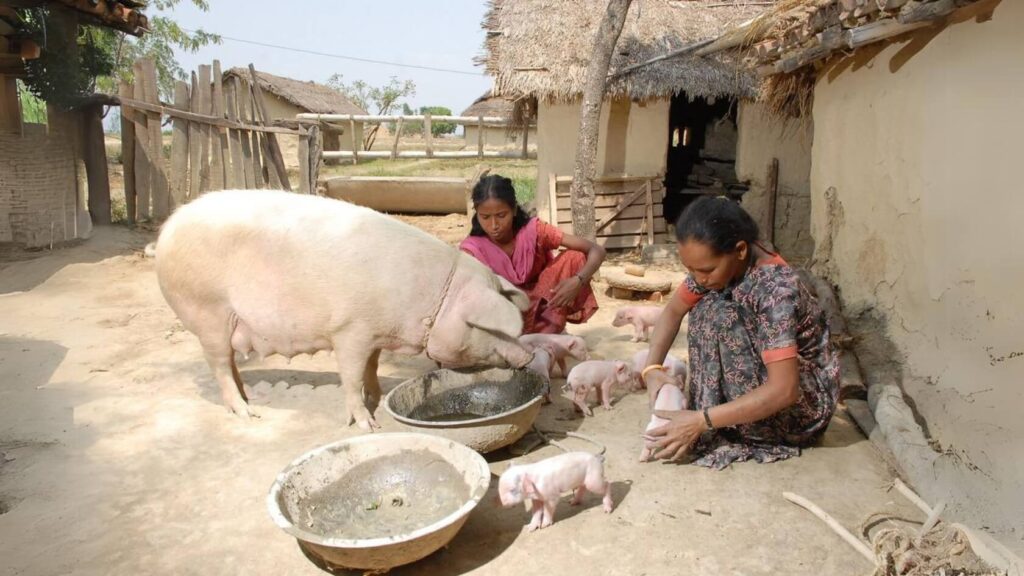
The key ingredients for home-mixed pig feeds typically include:
- Grains: Staple energy sources like corn, wheat, barley, or oats.
- Protein Sources: Plant-based options like soybean meal, cottonseed meal, or animal-based sources like fishmeal or meat and bone meal.
- Vitamins and Mineralsvital for fulfilling specific dietary needs and preserving general health.
Balancing the Nutrient Requirements
To ensure your home-mixed feed meets the nutritional needs of your pigs, it’s crucial to balance the following carefully:
| Nutrient | Importance |
| Protein and Amino Acids | Essential for growth, muscle development, and maintenance |
| Energy Sources | Provide the necessary calories for growth, reproduction, and other bodily functions |
| Vitamins and Minerals | Support various metabolic processes, immune function, and overall health |
| Water | Crucial for hydration, digestion, and temperature regulation |
Achieving the right balance requires precise formulation based on your pigs’ age, weight, and production stage. Consult a livestock nutritionist or follow established guidelines to ensure your home-mixed feed meets your herd’s specific requirements.
Advantages and Disadvantages of Home-Mixing
Home-mixing pig feeds offer several advantages, including:
- Cost Savings: You can reduce feed costs by sourcing ingredients locally and mixing your feed.
- Customization: You can tailor the feed to meet the specific needs of your herd or address any particular dietary requirements.
- Quality Control: You have complete control over the ingredients and can ensure the feed is free from contaminants or unwanted additives.
However, it also comes with some challenges, such as:
- Time and Labor: Home-mixing requires dedicated time and effort to source, mix, and store ingredients.
- Nutritional Imbalances: If not formulated correctly, home-mixed Pig feeds may lead to nutritional deficiencies or imbalances, affecting pig health and performance.
- Consistency: Maintaining consistent feed quality and formulation can be challenging, especially for more extensive operations.
Whether you choose commercial or home-mixed pig feeds, you must understand your herd’s nutritional needs and tailor the feed accordingly. Proper nutrition at every stage will ensure your pigs’ success and optimal growth, health, and productivity.
Nutritional Requirements for Pigs: Fueling Growth and Health
In this article, we’ll explore pigs’ critical nutritional requirements and the essential components that must be included in their feed to ensure optimal performance.
1. Protein and Amino Acids: Building Blocks for Growth
Protein is the critical nutrient responsible for muscle growth and development in pigs. It’s essential for supporting their rapid growth, especially during the early stages of life. But not every source of protein is made equal. For optimal health, pigs need a particular ratio of vital amino acids.
Essential Amino Acids for Pigs
As the building blocks of protein, amino acids are necessary for pigs’ diets to have enough of the following:
- Lysine: Crucial for growth, muscle development, and efficient feed utilization.
- Methionine: Supports protein synthesis, feather growth, and metabolism.
- Threonine: Necessary for maintaining gut health and immune function.
- Tryptophan: Plays a role in piglet development and behaviour.
- Valine, Isoleucine, and Leucine: These branched-chain amino acids are essential for muscle growth and maintenance.
Sources of High-Quality Protein
Pigs need high-quality protein sources to satisfy their amino acid needs. Among the most excellent choices are:
- Soybean Meal: a highly digested plant-based protein source whole of vital amino acids.
- Fish Meal: An excellent animal-based protein source with a well-balanced amino acid profile.
- Meat and Bone Meal: A byproduct of the meat industry, providing a concentrated source of protein and minerals.
- Synthetic Amino Acids: Commercially produced amino acids can be added to feed to ensure specific amino acid requirements are met.
2. Energy Sources: Fueling Growth and Maintenance
Energy is the driving force behind all bodily functions, including growth, reproduction, and maintenance. For pigs, energy is primarily derived from carbohydrates and fats.
Carbohydrates: The Primary Energy Source
Carbohydrates are pigs’ primary energy source, typically provided through corn, wheat, and barley grains. These grains are rich in starch, which is easily digestible and provides a steady energy supply.
Fats: Concentrated Energy for Growth and Reproduction
While carbohydrates are the primary energy source, fats also play a crucial role in meeting pigs’ energy demands. Fats are a highly concentrated energy source, providing more than twice the caloric value of carbohydrates or protein per unit of weight.
Fats are essential for sows during the late gestation and lactation stages, as they require additional energy to support the growth of their litters and milk production.
Managing Energy Levels
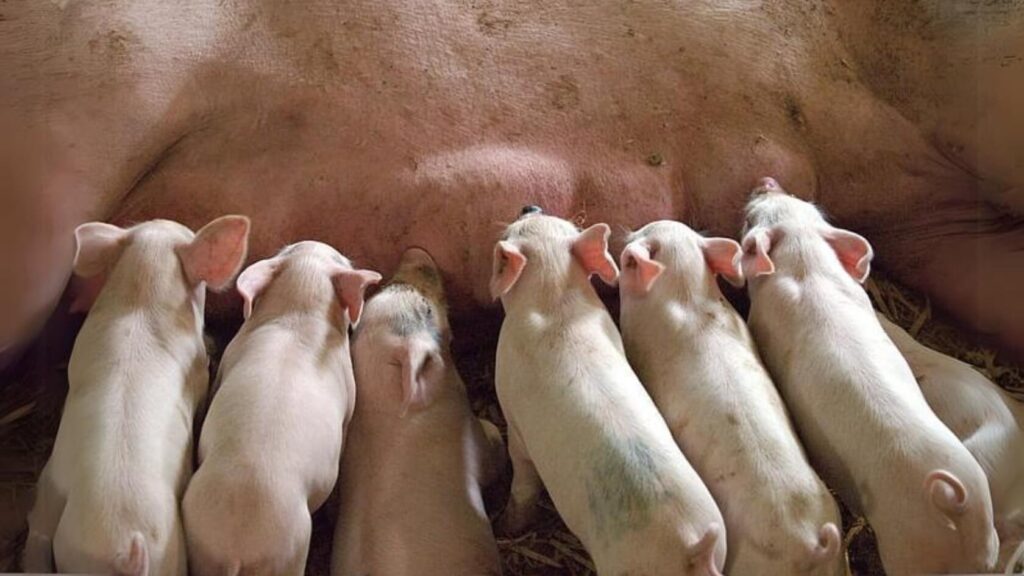
For pigs to operate at their best, the appropriate balance between energy intake and expenditure must be struck. Excess energy can lead to obesity and reduced feed efficiency, while insufficient energy can hinder growth and productivity.
To manage energy levels effectively, it’s crucial to consider the following factors:
- Growth Stage: Adjust energy levels based on the pig’s age and growth stage.
- Production Purpose: Breeding animals have different energy requirements than market animals.
- Environmental Conditions: Hot or cold environments can impact energy expenditure and requirements.
3. Vitamins and Minerals: Essential for Health and Performance
While protein and energy are the cornerstones of pig nutrition, vitamins and minerals are equally crucial for overall health, growth, and performance.
Essential Vitamins
Pigs require a variety of vitamins for various bodily functions, including:
- Vitamin A: Supports vision, reproduction, and immune function.
- Vitamin D: vital for absorbing calcium and phosphorus, which supports healthy bones and teeth.
- Vitamin E: Acts as an antioxidant, supporting immune function and muscle development.
- B-Complex Vitamins: Essential for energy metabolism, red blood cell formation, and nervous system function.
Macro and Micro Minerals
There are two categories of minerals: macrominerals and microminerals. Both are essential for various metabolic processes, growth, and overall health.
Macrominerals:
- Calcium and Phosphorus: Crucial for bone development, muscle function, and milk production in sows.
- Sodium and Chloride: Involved in maintaining proper fluid balance and acid-base regulation.
Potassium plays a role in muscle function, heart health, and nerve transmission.
Microminerals (Trace Minerals):
- Iron: Necessary for haemoglobin formation and oxygen transport.
- Zinc: Supports immune function, wound healing, and skin health.
- Copper: Involved in bone formation, red blood cell maturation, and enzyme function.
- Selenium: promotes immune system function and is an antioxidant.
Consequences of Deficiencies
Vitamin and mineral deficiencies can have severe consequences for pig health and performance. Symptoms may include:
- Poor growth.
- Reduced feed efficiency.
- Reproductive issues.
- A weakened immune system.
- Even mortality in severe cases.
4. Water Requirements: The Overlooked Nutrient
Water is often overlooked as a crucial nutrient, but it’s essential for maintaining all bodily functions in pigs. Proper hydration is necessary for digestion, temperature regulation, and the transport of nutrients throughout the body.
Importance of Clean Water
The quality of the water is just as important as its amount. Contaminated water can lead to health issues and negatively impact feed intake and growth.
Water Intake Based on Age and Weight
The amount of water a pig requires depends on several factors, including age, weight, and environmental conditions. As a general guideline, pigs consume the following amounts of water per day:
- Nursery Pigs (up to 50 lbs): 0.5 to 1 gallon per day
- Grower/Finisher Pigs (50 to 250 lbs): 1 to 2 gallons per day
- Gestating Sows: 3 to 6 gallons per day
- Lactating Sows: 6 to 8 gallons per day
Proper water management is crucial for ensuring your pigs have access to the right amount of clean water at all times, supporting their overall health and performance.
Understanding and meeting your pigs’ specific nutritional requirements will set them up for success. A balanced diet with proper protein, energy, vitamins, minerals, and water will support their development, health, and productivity. This will ultimately result in a more prosperous and long-lasting pig farming enterprise.
Mastering Feed Management for Optimal Pig Performance
Providing suitable feed is only half the battle for successful pig farming. Effective feed management practices are equally crucial to ensure your pigs receive the proper nutrition at the correct times while minimizing waste and maximizing efficiency. In this article, we’ll explore best practices for feed management, common feeding issues and their solutions, sustainable feeding practices, and a conclusion to wrap up our comprehensive guide on pig feed.
Feed Management: Strategies for Success
Proper feed management is essential for maintaining the health and productivity of your pig herd. Here are some key strategies to consider:
1. Feeding Schedules
Pigs require a regular feeding regimen to continue growing and performing at their best. The frequency and amount of feed should be tailored to each animal’s specific growth stage and weight.
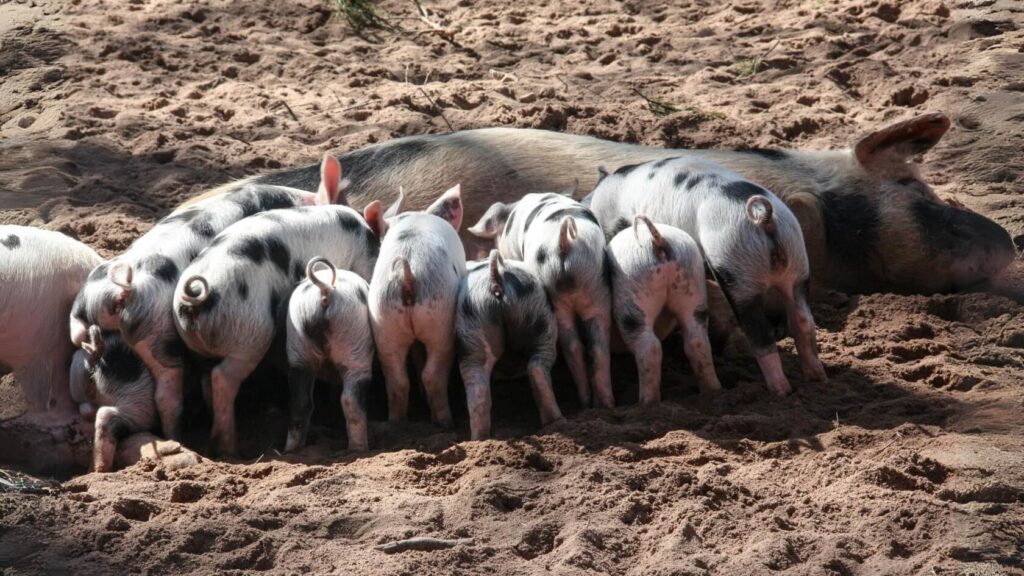
Feeding Frequency:
- Nursery Pigs (up to 50 lbs): Feed ad libitum (free-choice) or multiple small daily meals.
- Grower/Finisher Pigs (50 to 250 lbs): Feed 2-3 times per day or ad libitum.
- Gestating Sows: Feed once or twice daily, depending on body condition.
- Lactating Sows: Feed ad libitum or multiple times daily to support milk production.
Feed Amounts:
The amount of feed provided should be based on the pig’s age, weight, and production stage. Consult with a nutritionist or follow established guidelines to determine the appropriate feed amounts for your herd.
2. Feed Quality and Storage
Maintaining the quality of your feed is essential for ensuring optimal nutrient intake and preventing digestive issues or feed refusal. Here are some best practices for feed quality and storage:
- Inspect Feed Regularly: Check for signs of mould, spoilage, or contamination before feeding.
- Proper Storage Conditions: Store feed in a cold, dry, and well-ventilated location to avoid moisture accumulation and insect infestations.
- First-In, First-Out (FIFO): Rotate your feedstock to ensure older feed is used first, reducing the risk of spoilage.
- Clean Feeders and Troughs: Regularly clean and disinfect feeders and troughs to prevent mould or bacteria buildup.
3. Feed Additives and Alternatives
Certain additives and alternative feed sources can be incorporated into the core feed ingredients to enhance pig performance, health, and sustainability.
Antibiotic Growth Promoters (AGPs):
While controversial, AGPs have been used in pig production to improve growth rates and feed efficiency. However, their use is being phased out due to concerns over antibiotic resistance.
Probiotics and Prebiotics:
These feed additives can strengthen the immune system, enhance digestion and nutrient absorption, and preserve a balanced gut flora.
Alternative Protein Sources:
\
Researchers are exploring alternative protein sources, such as insect meal, algae, and other novel sources, to reduce reliance on traditional protein sources like soybean meal.
Common Feeding Issues and Solutions
Even with the best management practices, pig producers may encounter various feeding issues. Here are some common problems and their potential solutions:
1. Feed Refusal
Various factors, including illness, environmental stress, or low feed palatability, can cause refusal. If pigs consistently refuse to eat, take the following steps:
- Check the feed quality for signs of spoilage or contamination.
- Evaluate the feed formulation and consider adjusting the nutrient balance or palatability enhancers.
- Take care of any underlying health concerns and watch for any symptoms of illness or stress in the pigs.
- Ensure proper feeder management, including appropriate feeder space and height.
2. Digestive Issues
Digestive problems like diarrhoea, constipation, or bloating can be indicators of an imbalance in the pig’s diet or underlying health issues. To address the digestive problems:
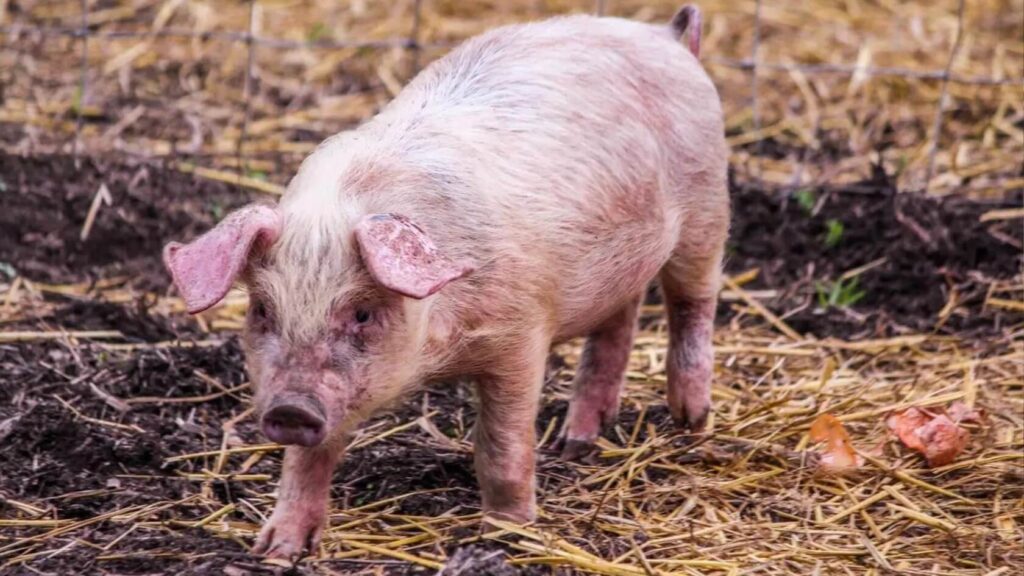
- Gradually transition to a new feed formulation or adjust the fibre content if necessary.
- Provide access to clean, fresh water to support hydration and digestion.
- See a veterinarian to rule out infectious infections or other possible health problems.
- Consider introducing probiotics or enzymes to support gut health and nutrient absorption.
3. Mycotoxin Contamination
Mycotoxins are poisonous compounds made by some types of mould that can contaminate feed and seriously harm pigs’ health. To prevent and manage mycotoxin contamination:
- Implement strict quality control measures during feed production, storage, and handling.
- Use mycotoxin binders or decontaminants in the feed to mitigate the effects of mycotoxins.
- Monitor pigs for signs of mycotoxin exposure, such as reduced feed intake, poor growth, and suppressed immune function.
- Regularly test feed samples for mycotoxin levels and discard contaminated feed promptly.
Addressing these common feeding issues promptly and implementing appropriate solutions can minimize disruptions to your pig’s growth and productivity while maintaining their overall health and well-being.
Sustainable Pig Feeding Practices
As the demand for pork grows, adopting sustainable feeding practices that minimize environmental impact and promote resource efficiency is essential. Here are some strategies to consider:
1. Reducing Feed Wastage
Feed wastage represents an economic loss and contributes to environmental pollution and resource depletion. To reduce feed wastage:
- Implement precision feeding systems that deliver the right amount of feed based on individual pig requirements.
- Regularly calibrate and maintain feeders to ensure proper feed delivery.
- Provide appropriate feeder space and design to minimize competition and feed spillage.
- Monitor feed intake and adjust formulations or feeding schedules to minimize leftovers.
2. Utilizing Local and Alternative Feedstuffs
Incorporating locally sourced and alternative feedstuffs can reduce transportation costs, support local economies, and diversify your feed sources. Explore options such as:
- Agricultural byproducts (e.g., wheat bran, corn distillers’ grains)
- Food waste and surplus (e.g., bakery byproducts, fruit and vegetable waste)
- Alternative protein sources (e.g., insect meal, algae, single-cell proteins)
However, it’s crucial to ensure these alternative feedstuffs meet the nutritional requirements of your pigs and are properly processed and stored to maintain quality and safety.
3. Recycling and Reusing Agricultural Byproducts
Pig farming generates various byproducts, such as manure and waste, which can be recycled and reused in sustainable ways:
- Implement effective management systems to capture and process manure for fertilizer or biogas production.
- Explore opportunities to use agricultural waste (e.g., corn stover, wheat straw) as bedding material or supplemental feed.
- Collaborate with local farms and businesses to create closed-loop systems where waste from one operation becomes a valuable input for another.
Adopting sustainable feeding practices can reduce your environmental footprint, increase resource efficiency, and contribute to a more circular and regenerative agricultural system.
Conclusion: Unlocking the Potential of Pig Feed
Throughout this comprehensive guide, we’ve explored the intricate world of pig feed, from understanding the different types and nutritional requirements to mastering feed management, addressing common issues, and embracing sustainable practices.
Providing suitable feed is the foundation for raising healthy, productive pigs. By carefully selecting and formulating Pig feeds to meet your herd’s needs, you can optimize growth, improve feed efficiency, and enhance overall performance.

Effective feed management is equally crucial. It ensures that the suitable feed is delivered at the right time, in the right amounts, and under the right conditions. Addressing common feeding issues promptly and implementing appropriate solutions can help maintain your pigs’ health and productivity.
As we look towards the future, embracing sustainable feeding practices will become increasingly important. By reducing feed wastage, exploring alternative feedstuffs, and recycling agricultural byproducts, we can minimize our environmental impact while maximizing resource efficiency.
Remember, successful pig farming is a continuous journey of learning and adaptation. Keep up with recent research and industry best practices to give your herd the most care possible. You may also seek advice from professionals like veterinarians and nutritionists.
With the knowledge and strategies outlined in this guide, you’ll be well-equipped to navigate the world of pig feed, unlock your animals’ full potential, and achieve long-term success in farming.

